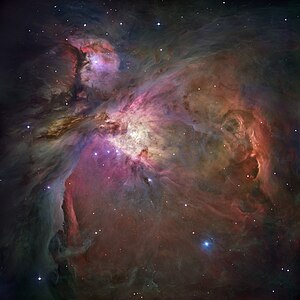Orion Nebula
| Diffuse nebula | |
|---|---|

The entire Orion Nebula in a composite image of visible light and infrared.
|
|
| Observation data: J2000 epoch | |
| Subtype | Reflection/Emission |
| Right ascension | 05h 35m 17.3s |
| Declination | −05° 23′ 28″ |
| Distance | 1,344±20 ly (412 pc) |
| Apparent magnitude (V) | +4.0 |
| Apparent dimensions (V) | 65×60 arcmins |
| Constellation | Orion |
| Physical characteristics | |
| Radius | 12 ly |
| Absolute magnitude (V) | — |
| Notable features | Trapezium cluster |
| Designations |
NGC 1976, M42, LBN 974, Sharpless 281 |
The Orion Nebula (also known as Messier 42, M42, or NGC 1976) is a diffuse nebula situated in the Milky Way, being south of Orion's Belt in the constellation of Orion. It is one of the brightest nebulae, and is visible to the naked eye in the night sky. M42 is located at a distance of 1,344 ± 20 light years and is the closest region of massive star formation to Earth. The M42 nebula is estimated to be 24 light years across. It has a mass of about 2000 times the mass of the Sun. Older texts frequently refer to the Orion Nebula as the Great Nebula in Orion or the Great Orion Nebula.
The Orion Nebula is one of the most scrutinized and photographed objects in the night sky, and is among the most intensely studied celestial features. The nebula has revealed much about the process of how stars and planetary systems are formed from collapsing clouds of gas and dust. Astronomers have directly observed protoplanetary disks, brown dwarfs, intense and turbulent motions of the gas, and the photo-ionizing effects of massive nearby stars in the nebula.
The nebula is visible with the naked eye even from areas affected by some light pollution. It is seen as the middle "star" in the "sword" of Orion, which are the three stars located south of Orion's Belt. The star appears fuzzy to sharp-eyed observers, and the nebulosity is obvious through binoculars or a small telescope. The peak surface brightness of the central region is about 17 Mag/arcsec2 (about 14 millinits) and the outer bluish glow has a peak surface brightness of 21.3 Mag/arcsec2 (about 0.27 millinits). (In the photos shown here the brightness, or luminance, is enhanced by a large factor.)
...
Wikipedia
